

Brown v. Board of Education. Opinion WARREN, C.J., Opinion of the Court [p*486] MR.
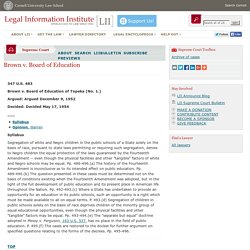
History - Brown v. Board of Education Re-enactment. The Plessy Decision Although the Declaration of Independence stated that "All men are created equal," due to the institution of slavery, this statement was not to be grounded in law in the United States until after the Civil War (and, arguably, not completely fulfilled for many years thereafter).
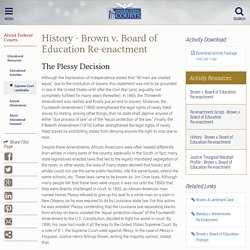
In 1865, the Thirteenth Amendment was ratified and finally put an end to slavery. Brown v. Board of Education. "In these days, it is doubtful that any child may reasonably be expected to succeed in life if he is denied the opportunity of an education.

Such an opportunity, where the state has undertaken to provide it, is a right that must be made available on equal terms. The Supreme Court . Expanding Civil Rights . Landmark Cases . Brown v. Board of Education (1954) Mother (Nettie Hunt) and daughter (Nickie) sit on steps of the Supreme Court building on May 18, 1954, the day following the Court's historic decision in Brown v.
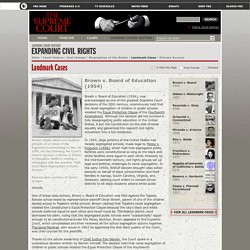
Board of Education. Nettie is holding a newspaper with the headline "High Court Bans Segregation in Public Schools. " Reproduction courtesy of Corbis Images. Separate but Equal: Segregation in the Public Schools. Introduction The issue of whether public facilities may be segregated based on race first arose in the context of transportation, not education.
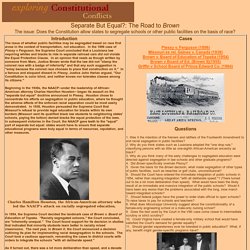
In the 1896 case of Plessy v Ferguson, the Supreme Court concluded that a Louisiana law requiring whites and blacks to ride in separate railroad cars did not violate the Equal Protection Clause. In an opinion that reads as though written by someone from Mars, Justice Brown wrote that the law did not "stamp the colored race with a badge of inferiority" and that any such suggestion is "soley because the colored race chooses to place that construction on it. " In a famous and eloquent dissent in Plessy, Justice John Harlan argued, "Our Constitution is color blind, and neither knows nor tolerates classes among its citizens. " Brown v. Board of Education of Topeka, Kansas - Brown v. Board at Fifty: "With an Even Hand" Three lawyers confer at the Supreme Court, 1953.
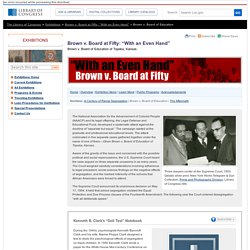
Gelatin silver print. New York World-Telegram & Sun Collection, Prints and Photographs Division, Library of Congress (98) The National Association for the Advancement of Colored People (NAACP) and its legal offspring, the Legal Defense and Educational Fund, developed a systematic attack against the doctrine of “separate but equal.” Documents Related to Brown v. Board of Education.
Background On May 17, 1954, U.S.
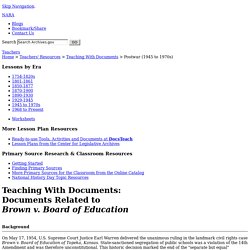
Supreme Court Justice Earl Warren delivered the unanimous ruling in the landmark civil rights case Brown v. Board of Education of Topeka, Kansas. State-sanctioned segregation of public schools was a violation of the 14th Amendment and was therefore unconstitutional. Integration of Central High School - Black History. In the following weeks, federal judge Richard Davies began legal proceedings against Governor Faubus, and President Dwight D.

Eisenhower attempted to persuade Faubus to remove the National Guard and let the Little Rock Nine enter the school. Judge Davies ordered the Guard removed on September 20, and the Little Rock Police Department took over to maintain order. Little Rock Crisis, 1957. 101st Airborne Div.
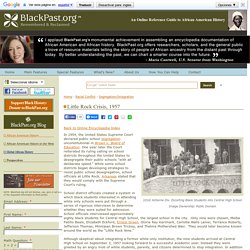
Escorting Black Students into Central High School Image Ownership: Public Domain. Little Rock Central High School. The Little Rock Central High School incident of 1957 in Arkansas brought international attention to the civil rights cause.

The Montgomery Bus Boycott may have been important but it hardly had media appeal. Here at Little Rock, you had a state fighting against federal authority, national guard troopers facing professional paratroopers and a governor against a president. The Brown Trial (1951) Little Rock Central High School Integration. Home » Events » Little Rock Central High School Integration Background: The desegregation of Central High School in Little Rock, Arkansas, gained national attention on September 3, 1957, when Governor Orval Faubus mobilized the Arkansas National Guard in an effort to prevent nine African American students from integrating the high school. After several failed attempts to negotiate with Faubus, President Dwight D.
Eisenhower took action against the defiant governor by simultaneously federalizing the Arkansas National Guard, removing the Guard from Faubus' control, and ordering one thousand troops from the United States Army 101st Airborne Division in Ft. Eisenhower Presidential Library. On May 17, 1954, the U.S.
Supreme Court ruled in Brown vs. Topeka Board of Education that segregated schools are "inherently unequal. " Welcome to OurDocuments.gov. This executive order of September 23, 1957, signed by President Dwight Eisenhower, sent Federal troops to maintain order and peace while the integration of Central High School in Little Rock, AR, took place. On May 17, 1954, the U.S. Supreme Court ruled in Brown v. Topeka Board of Education that segregated schools were "inherently unequal" and ordered that U.S. public schools be desegregated "with all deliberate speed.
" Within a week of the 1954 decision, Arkansas was one of two Southern states to announce it would begin immediately to take steps to comply with the Brown decision. Arkansas's law school had been integrated since 1949, and seven of its eight state universities had desegregated. On September 2, the night before school was to start, Arkansas Governor Orval Faubus called out the state's National Guard to surround Little Rock Central High School and prevent any black students from entering.
American Experience.Eyes on the Prize.Video and More. Video and More This Web site explores 25 major events of the Civil Rights Movement, as told in the 14 hours of the Eyes on the Prize television series. Each part of the Story of the Movement section includes resources like newspaper clippings, music, video, image galleries, and quotes from people involved in the movement. A 26th section addresses civil rights in America today. Use this section of the Web site as a site map organized by type of content.
Visit the pages below to see complete lists of all the video and other resources on the site, and to access them directly. Image GalleriesSee a chronological list of all the site's image galleries. 100 Years of History. W.E.B. DuBois | Charles Hamilton Houston | Oscar Micheaux | Harry T. and Harriette Moore | Martin Luther King, Jr. | Rosa Parks | Medgar Evers | Myrlie Evers-Williams | James Weldon Johnson | Mary White Ovington | Roy Wilkins | Carter G. Woodson Anti-Lynching Bill | Costigan-Wagner Bill | Voting Rights Act | Lift Ev'ry Voice and Sing. Higher Bitesize History - Race relations between the wars : Revision, Page2.
Ku Klux Klan - Facts & Summary. In 1915, white Protestant nativists organized a revival of the Ku Klux Klan near Atlanta, Georgia, inspired by their romantic view of the Old South as well as Thomas Dixon’s 1905 book “The Clansman” and D.W. Griffith’s 1915 film “Birth of a Nation.” This second generation of the Klan was not only anti-black but also took a stand against Roman Catholics, Jews, foreigners and organized labor. It was fueled by growing hostility to the surge in immigration that America experienced in the early 20th century along with fears of communist revolution akin to the Bolshevik triumph in Russia in 1917. The organization took as its symbol a burning cross and held rallies, parades and marches around the country. Brown v. Board of Education (1954) Brown v. Board of Education, II (1955) May 31, 1955, Opinion and judgments announced OPINION: MR. Higher Bitesize History - Race relations between the wars : Revision, Page2.
Ku Klux Klan Facts, information, pictures. The Ku Klux Klan (KKK) is a white supremacist organization that was founded in 1866. U.S. Civil Rights Movement (1950s-1960s) Voices of Struggle: The Civil Rights movement, 1945 to 1965. Investigating US History. Premilla Nadasen Queens College, CUNY Overview: Address on Civil Rights (June 11, 1963)—Miller Center. Independent Lens . FEBRUARY ONE . Civil Rights and Non-Violence.
Civil Rights Movement. Civil Rights Movement: "Black Power" Era Summary & Analysis. A Carefully Planned March. Civil Rights Timeline. The Civil Rights Movement: 1919-1960s, Freedom's Story, TeacherServe®, National Humanities Center. Civil Rights Movement - Black History.